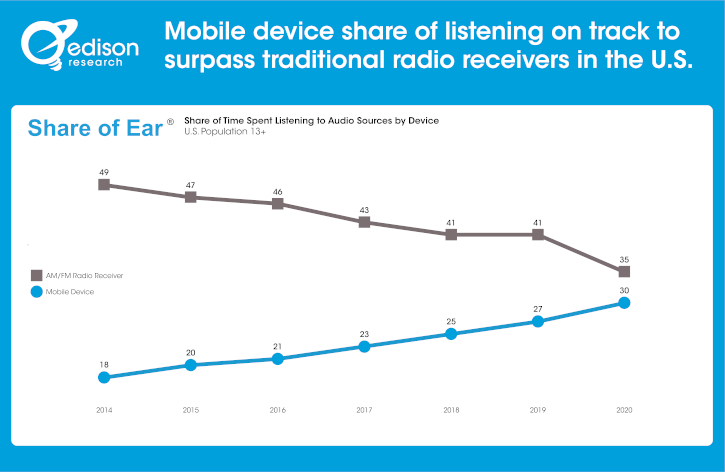More listening is being done on mobile devices than ever before.
According to new research by Edison Research as part of its Share of Ear report, 30% of all audio listening in the U.S. is now being done on a mobile device by those aged 13 and older. This is an increase of 67% since 2014 when Edison began tracking audio consumption among Americans.
While listening to traditional AM/FM radio still accounts for the largest share of audio consumed, the gap between traditional radio and mobile devices is closing. In 2014, 31 percentage points separated the two; in 2021 the two are only separated by two percentage points.
[Read: Share of Listening to Podcasting Hits All-Time High]
Among younger age groups, audio consumption through mobile devices has already surpassed traditional radio receivers. Among those aged 13 to 34, 46% of total daily audio consumption is done on a mobile device while 20% is done on a traditional AM/FM radio receiver.
One potential reason: the coronavirus pandemic caused many Americans to spend more time consuming audio at home in 2020 and less time consuming in-car audio, which has been the prime location for listening to a traditional AM/FM receiver.

“Mobile devices, particularly of course the phone, have been gaining on the traditional radio receiver as the primary listening device for as long as we have been measuring Share of Ear, but with the disruptions of the last year the gap has narrowed dramatically,” said Edison Research President Larry Rosin. “As fewer people have a standard radio receiver in their homes these days, naturally more listening comes through digital devices.”
Edison noted that these statistics speak to the device only, not the audio product being delivered by the device. This is important to clarify because mobile devices can deliver a wide range of audio products, including radio station programming, the report said.
Edison plans to conduct additional data analysis later this year to see if these audio habits remain in a post-quarantine world.
The Share of Ear study is released quarterly and is designed to be a nationally representative study of Americans aged 13 and older to measure their time spent listening to audio sources. The research study asks respondents to complete a 24-hour diary of their audio listening on an assigned day with diaries completed both online and by mail.












